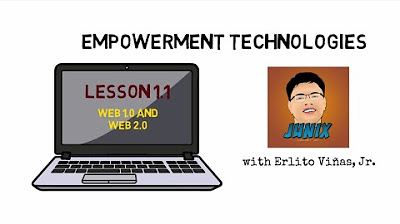Introduction to the Web
Summary
TLDRThe video script explores the evolution of the World Wide Web, tracing its journey from static, text-based pages in the early 1990s to the dynamic, interactive platforms of today. It highlights the development of technologies like CGI and JavaScript, which enabled more personalized and engaging user experiences. The concept of Web 2.0 is introduced, where HTTP became a general transport mechanism, and servers generated dynamic content tailored to users. By the mid-2000s, the web had transformed into a platform-agnostic operating system, accessible across different devices and operating systems, marking a pivotal shift in how we interact with the internet.
Takeaways
- 😀 The web originated as a vast network of interconnected servers that served documents, primarily text-based with some formatting.
- 😀 The term 'web' was used to describe the interconnected nature of documents, differentiating it from the 'internet', which is the network of servers themselves.
- 😀 Early web documents were static, with limitations in interactivity and dynamic content generation.
- 😀 CGI (Common Gateway Interface) was the primary way to interact with servers for dynamic content, but it was complex and had many limitations.
- 😀 The 'browser wars' in the 1990s saw different companies (Microsoft, Mozilla, Netscape) vying for dominance, leading to compatibility issues across browsers.
- 😀 Web 2.0 emerged around 2004, introducing dynamic, on-the-fly page generation, which transformed the web into a more interactive and user-specific experience.
- 😀 HTTP evolved from being a hypertext-specific protocol to a more general data transport mechanism, capable of handling a variety of content types like images, videos, and forms.
- 😀 Dynamic content generation allowed for a more personalized web experience, with servers tracking user behavior and tailoring content accordingly.
- 😀 Browser power and processing improvements allowed for offloading work to the client-side, with technologies like JavaScript enhancing interactivity on web pages.
- 😀 The web became platform-agnostic, meaning applications could run consistently across various operating systems, including Windows, Mac, Linux, and mobile devices.
Q & A
What inspired the use of the term 'web' in reference to the World Wide Web?
-The term 'web' was inspired by the interconnecting network of servers and documents, which resembled a spider's web, with wires crisscrossing each other. This metaphor captured the nature of the web as a vast network of interconnected documents.
What is the primary distinction between the 'internet' and the 'web'?
-The internet refers to the network of connected servers, while the web specifically refers to the interconnected documents that are shared across these servers. The web is built on top of the internet and uses it as a medium to deliver information.
How did the World Wide Web evolve in the early 1990s?
-In the early 1990s, the World Wide Web was primarily a collection of static text documents served by web servers. This was a simple, one-way form of communication, where servers would only provide fixed information in response to user requests.
What were some challenges developers faced with web development in the 1990s?
-One of the major challenges in the 1990s was browser compatibility, as different companies created their own browsers with varying standards. This led to the 'browser wars' where it was difficult to ensure that websites worked properly across all browsers.
What technological advancement led to the concept of Web 2.0?
-The concept of Web 2.0 emerged around 2004, as web pages started to be dynamically generated on the fly. This allowed websites to serve personalized content and interact with users in real-time, rather than just displaying static information.
How did the shift from static to dynamic web pages impact user experience?
-The shift to dynamic web pages allowed for more personalized and interactive experiences. Websites could now respond to user inputs and preferences, such as remembering shopping carts or customizing content based on the user's location or device.
What role did JavaScript play in the evolution of the web?
-JavaScript played a crucial role in making web pages more interactive by allowing dynamic content to be processed and rendered on the client-side (in the browser). It enabled features like real-time updates, animations, and enhanced user interactivity, improving the overall user experience.
How did the growth of server-side computing influence the web's development?
-With the growth of server-side computing and more powerful machines, servers could now generate dynamic content tailored to individual users. This allowed for complex web applications like online shopping carts, personalized content, and real-time data processing.
What does it mean for the web to be 'platform agnostic'?
-Being 'platform agnostic' means that web applications and websites can function across various operating systems (such as Windows, Mac, or Linux) without needing to be rewritten for each one. This was made possible by browsers, which became standardized and capable of running on any device or OS.
How did the evolution of browsers contribute to the Web becoming a universal platform?
-Browsers became more powerful and standardized over time, allowing them to run on multiple operating systems and devices. This made the web a universal platform where developers could write code once and be confident it would work across different devices and operating systems.
Outlines

此内容仅限付费用户访问。 请升级后访问。
立即升级Mindmap

此内容仅限付费用户访问。 请升级后访问。
立即升级Keywords

此内容仅限付费用户访问。 请升级后访问。
立即升级Highlights

此内容仅限付费用户访问。 请升级后访问。
立即升级Transcripts

此内容仅限付费用户访问。 请升级后访问。
立即升级浏览更多相关视频

3- كيف بدأ الإنترنت ؟ وما هو اول موقع تم انشاءه | دورة اختبار اختراق تطبيقات الويب

Sejarah Website | Teknologi | Bertiga Network | Episode#9 Part 1

Evolution of Web Design 1990-2019

Empowerment Technologies | Lesson 1.1: Web 1.0 and Web 2.0

A Brief History of the Internet

Web pages, Websites, and Web Applications
5.0 / 5 (0 votes)
